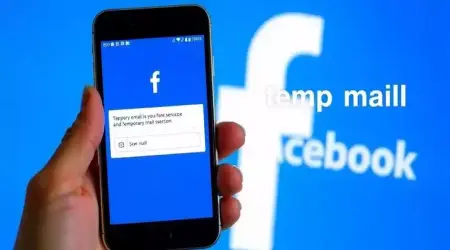

How to protect Twitter account with temp mail
In today's digital age, keeping your Twitter account safe is more important than ever. One effective way to enhance your security is by using temporary email services. These services allow you to create a disposable email address that can be used for account creation and verification, without exposing your personal email. This not only helps protect your privacy but also shields you from spam and phishing attacks. Let's explore how you can protect your Twitter account with temp mail and maintain your online safety.
Key Takeaways
Using a temporary email keeps your real email private, reducing spam.
Temp mail helps you avoid phishing attempts by not linking personal info.
Setting up unique passwords and two-factor authentication is crucial.
Manage notifications to catch suspicious activity early.
Choose a reliable temp mail provider for better security features.
Enhancing Security With Temporary Email
Understanding Temp Mail Services
Temp mail services are like secret agents for your inbox. Instead of using your regular email address when signing up for things online, you use a temporary one. Think of it as a shield against potential spam and privacy breaches. These services give you a disposable email address that you can use for a short period. Once you're done with it, you can simply let it expire. It's a great way to keep your real email address safe and clean. disposable email addresses are a great way to avoid spam.
Benefits of Using Temp Mail for Twitter
Using temp mail for Twitter has some pretty cool advantages. First off, it helps you avoid spam. Nobody wants a flooded inbox, right? By using a temporary email, you're essentially creating a buffer between your real email and any potential junk. It also adds an extra layer of security. If a website gets hacked, your real email address isn't compromised. Plus, it's super handy for testing out new services or features without committing your main email.
How Temp Mail Protects Your Privacy
Temp mail is a solid tool for protecting your privacy. When you sign up for services with your real email, you're essentially giving away a piece of your personal information. This info can be used for tracking, marketing, or even worse, identity theft. Temp mail keeps your real email address hidden, making it harder for companies and individuals to collect data about you. It's like wearing a mask online – you're still there, but your true identity remains concealed.
Using temp mail is a simple way to take control of your online privacy. It's not a perfect solution, but it's a step in the right direction. By minimizing the exposure of your real email address, you reduce the risk of spam, phishing, and other online threats.
Preventing Spam and Phishing Attacks
How Temp Mail Reduces Spam
Using a temporary email address is a solid way to cut down on the amount of spam you receive. When you sign up for Twitter with a temp mail, your real email stays hidden. This means spammers can't easily get to it. Think of it as a shield for your primary inbox.
Keeps your main email clean.
Reduces the risk of accidentally clicking on malicious links.
Makes it harder for marketers to track you.
It's a simple step that can make a big difference in your daily online life. I started using temp mail for new accounts, and the amount of junk mail I get has dropped significantly. It's like a breath of fresh air for my inbox.
Identifying Phishing Attempts
Phishing attempts are sneaky. They often look like legitimate emails from Twitter, asking you to verify your account or reset your password. But they're actually trying to steal your information. If you use a temp mail, you can easily spot these scams. Since you know you only used that email for Twitter, any unexpected emails are a red flag. It's like having a built-in spam filter that's tailored just for you. You can also set up account alerts to notify you of suspicious activity.
Using Temp Mail for Account Verification
When you sign up for Twitter, they usually send a verification email. Instead of using your real email, use a temp mail. Once you've verified your account, you don't need that email address anymore. This prevents Twitter (or anyone who gets their hands on their database) from sending you unwanted emails in the future. Plus, if there's a data breach, your real email address is safe. It's a simple way to add an extra layer of security to your online presence.
Here's a quick rundown:
Sign up for Twitter with a temp mail.
Verify your account.
Forget about the temp mail.
Enjoy a spam-free experience.
Safeguarding Personal Information

Keeping Your Real Email Private
Using a temporary email address is a smart move to keep your actual email under wraps. Think of it like this: you're giving out a burner phone number instead of your main one. This way, all those sign-up confirmations and newsletters go to the temp email, not cluttering your personal inbox. It's a simple step that can make a big difference in managing your online footprint. I've found it especially useful for sites I'm not sure about; it's like a safety net.
Avoiding Identity Theft
Identity theft is a serious concern, and using temp mail can add an extra layer of protection. When you sign up for services with your real email, you're potentially exposing it to data breaches. If a site gets hacked, your email could end up in the wrong hands. By using a temporary email, you're limiting the amount of personal information tied to that specific account. It's not a foolproof solution, but it's a good habit to get into. I always use a temp email for anything that seems even slightly risky.
Using Disposable Emails for Sensitive Accounts
For accounts where you share sensitive information, like financial details or personal documents, it's best to avoid using temp mail. However, for less critical accounts, disposable emails can be a great way to minimize your risk. Think of it as segmenting your online life. Keep your main email for important stuff and use temp emails for everything else. It's all about reducing your exposure. You can find tools that scan and compare email addresses in real-time, helping you avoid issues related to disposable emails.
Using temp mail is not a replacement for strong passwords and good online habits. It's just one tool in your arsenal for protecting your personal information. Always be cautious about the information you share online, no matter what email address you're using.
Here's a quick rundown:
Use a strong, unique password for every account.
Enable two-factor authentication whenever possible.
Be wary of phishing attempts.
Regularly review your account activity.
Setting Up Your Twitter Account Securely
It's easy to jump into using Twitter, but taking a few extra steps to secure your account from the start can save you a lot of headaches later. Think of it as building a strong fence around your digital property. It's worth the effort.
Creating a Unique Password
Your password is the first line of defense. Don't reuse passwords from other sites. If one site gets hacked, all your accounts with that password are at risk. Use a mix of upper and lowercase letters, numbers, and symbols. The longer and more random, the better. Consider using a password manager to generate and store strong passwords. It's way easier than trying to remember a bunch of complicated strings.
Enabling Two-Factor Authentication
Two-factor authentication (2FA) adds an extra layer of security. Even if someone gets your password, they'll need a second code from your phone or another device to log in. It's like having a lock and a key. Most services offer 2FA through an app like Google Authenticator or Authy, or via SMS. I recommend using an authenticator app for enhanced Twitter security, as SMS can be intercepted. Setting it up only takes a few minutes, and it's a huge boost to your account's safety.
Adjusting Privacy Settings
Twitter gives you a lot of control over who sees your tweets and interacts with you. Go into your settings and review each option carefully. You can protect your tweets so only your followers see them. You can also control who can send you direct messages. Think about what you're comfortable sharing publicly and adjust accordingly. It's all about finding the right balance between being social and protecting your personal information.
Taking the time to adjust your privacy settings is like setting boundaries in real life. It's about deciding who you want to let into your space and what information you're willing to share. Don't be afraid to experiment and adjust as needed. Your comfort and safety are what matters most.
Managing Account Alerts and Notifications
It's easy to overlook account alerts and notifications, but they're a key part of keeping your Twitter account secure. By setting them up correctly, you can quickly spot any weird activity and take action before things get out of hand. Think of it as having a security guard watching over your account 24/7.
Setting Up Login Alerts
Login alerts are like a heads-up display for your account security. Whenever someone logs in from a new device or location, you'll get a notification. This is super useful because if it's not you, you know something's up. You can usually set this up in your account settings under security or login activity. Make sure you have this enabled; it's one of the easiest ways to catch unauthorized account access.
Understanding Account Activity Notifications
Twitter sends all sorts of notifications, but it's important to know which ones to pay attention to. Obvious ones are password change requests or email address updates. But also keep an eye out for unusual activity, like a sudden spike in tweets you didn't send or follows you didn't initiate. These could be signs that your account has been compromised. Here's a quick rundown:
Login Alerts: As mentioned, these are critical.
Password Change Requests: If you didn't request it, change your password immediately.
Unusual Tweet Activity: Keep an eye on your timeline.
New Follows/Unfollows: Check for suspicious patterns.
Ignoring these notifications is like leaving your front door unlocked. It only takes a minute to review them, and it could save you a lot of headaches down the road.
Responding to Suspicious Activity
Okay, so you've spotted something fishy. What now? First, change your password immediately. Use a strong, unique password that you haven't used anywhere else. Next, review your recent activity and revoke access to any third-party apps you don't recognize. Finally, consider enabling two-factor authentication for an extra layer of security. Here's a simple checklist:
Change your password.
Review and revoke app access.
Enable two-factor authentication.
Report the suspicious activity to Twitter.
Using Temp Mail for Short-Term Accounts
Creating Temporary Accounts on Twitter
Sometimes, you might want to explore Twitter without fully committing to a long-term account. Maybe you're researching a specific topic, testing out a new strategy, or just want to observe without leaving a digital footprint. That's where using a temporary email address comes in handy. It allows you to create an account without linking it to your primary email, giving you the freedom to experiment. It's pretty straightforward: sign up for a disposable email address from a provider, use that email to create your Twitter account, and you're good to go. Just remember, once the email expires, you might lose access to the account, so this is best for short-term use.
Benefits of Short-Term Email Usage
There are several reasons why using a temporary email for short-term Twitter accounts is a smart move. First, it keeps your main inbox clean. No one wants a flood of notifications and promotional emails from a platform they're only using temporarily. Second, it protects your privacy. You're not sharing your personal email address with a platform you might not fully trust. Third, it's great for testing. Want to see how different content performs without affecting your main account's analytics? A temporary account is perfect. Finally, it's quick and easy. Setting up a 10 Minute Mail takes seconds, and you can start using Twitter right away.
Avoiding Long-Term Spam
One of the biggest headaches of using social media is the potential for spam. Even if you carefully curate your follows and interactions, your email address can still end up on spam lists. By using a temporary email for accounts you don't plan to use long-term, you significantly reduce the risk of your primary inbox getting bombarded with unwanted messages. It's a simple precaution that can save you a lot of time and frustration in the long run. Think of it as a digital firewall for your personal email.
Using temp mail for short-term accounts is a great way to explore Twitter without the commitment. It keeps your inbox clean, protects your privacy, and allows you to test things out without affecting your main account. Just remember to use it responsibly and be aware of the limitations.
Choosing the Right Temp Mail Provider

It's important to pick a good temp mail service. Not all of them are created equal, and some might even be risky to use. You want one that's reliable and actually protects your privacy. Let's look at what to consider.
Evaluating Temp Mail Services
When you're checking out different temp mail services, think about what you need. Do you just want a basic, free service for quick sign-ups? Or do you need something more robust with extra features? Some services offer more than just a temporary inbox. They might have features like custom domains, email forwarding, or even the ability to send emails. Consider how often you'll use the service and what you'll be using it for. For example, if you're planning to use disposable email addresses for multiple accounts, you might want a service that lets you manage several addresses at once.
Features to Look For
Here's a list of features to consider:
Longevity: How long does the email address stay active? Some only last 10 minutes, while others last longer.
Privacy: Does the service have a clear privacy policy? Do they log your IP address or other personal information?
Ease of Use: Is the website or app easy to navigate? Can you quickly create and access your temporary email address?
Customization: Can you choose your email address, or is it randomly generated?
Security: Does the service offer encryption or other security features to protect your emails?
It's also a good idea to check if the service blocks certain domains or IP addresses. Some websites block known temp mail providers, so you'll want to make sure the service you choose works with the sites you plan to use it on.
User Reviews and Recommendations
Before you commit to a temp mail provider, see what other people are saying. Look for reviews on tech websites, forums, or even social media. Pay attention to what people say about the service's reliability, privacy, and customer support. If a lot of users are reporting problems with spam or security, that's a red flag. Also, consider the source of the reviews. Are they from reputable websites, or do they seem fake or biased? Real user experiences can give you a better idea of what to expect from a service. You can also ask for recommendations from friends or colleagues who use temp mail services. They might have some good suggestions based on their own experiences.
Final Thoughts on Using Temp Mail for Twitter Security
In conclusion, using a temporary email like Temp Mail can really help keep your Twitter account safe. It’s a simple way to avoid spam and protect your personal info. By creating a disposable email, you can sign up for Twitter without giving away your real address, which is a smart move in today’s online world. Plus, it helps you dodge those pesky phishing attempts. Just remember to combine this with strong passwords and two-factor authentication for even better security. So, if you’re looking to keep your Twitter experience clean and secure, give Temp Mail a shot!
Frequently Asked Questions
What is a temporary email service?
A temporary email service provides a short-term email address that you can use for signing up for websites without giving your real email.
How does using temp mail help my Twitter account?
Using temp mail helps keep your real email private, reduces spam, and protects you from phishing attacks.
Can I use temp mail for other online accounts?
Yes, you can use temporary email addresses for any online account where you want to avoid sharing your real email.
How long does a temporary email address last?
Most temporary email addresses last for a short time, often around 10 to 60 minutes, but some services may allow longer use.
Is using temp mail safe?
Yes, using temp mail is generally safe as it helps keep your personal information private and protects against spam.
Do I need to pay for temp mail services?
Many temp mail services are free, but some offer premium features for a fee.

